Module 11 Way of life模块复习课件(共38张PPT)
文档属性
| 名称 | Module 11 Way of life模块复习课件(共38张PPT) |  | |
| 格式 | pptx | ||
| 文件大小 | 206.2KB | ||
| 资源类型 | 教案 | ||
| 版本资源 | 外研版 | ||
| 科目 | 英语 | ||
| 更新时间 | 2022-06-26 20:17:20 | ||
图片预览

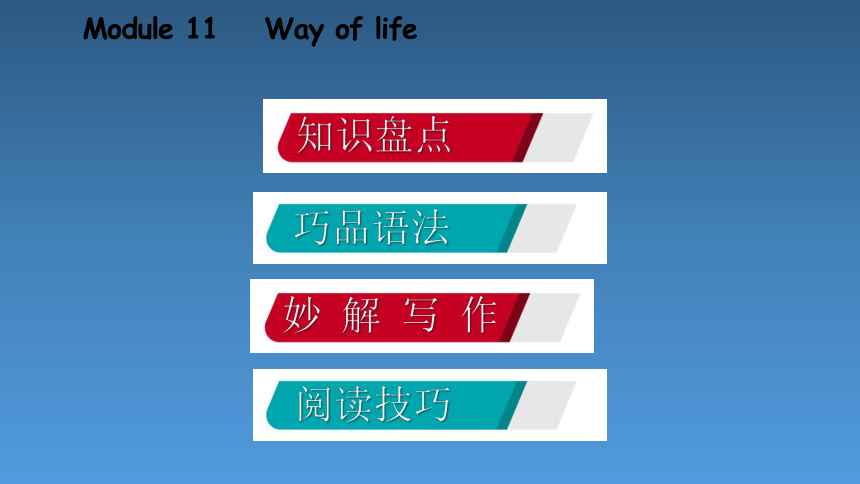

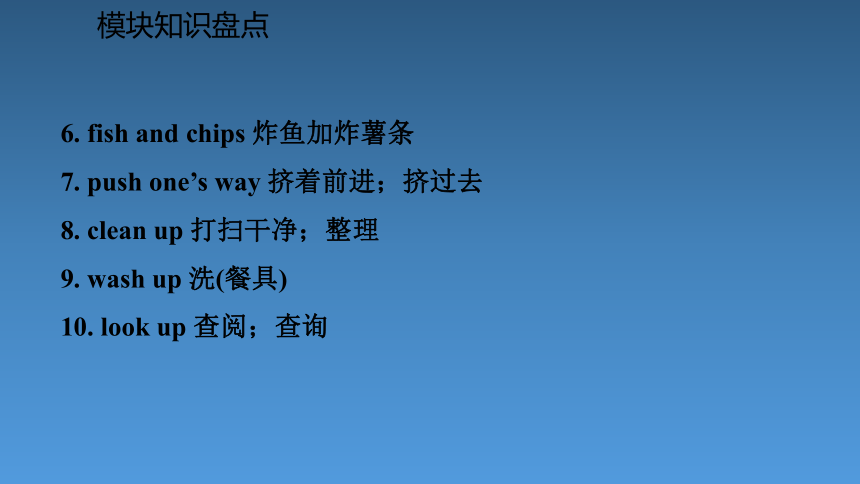
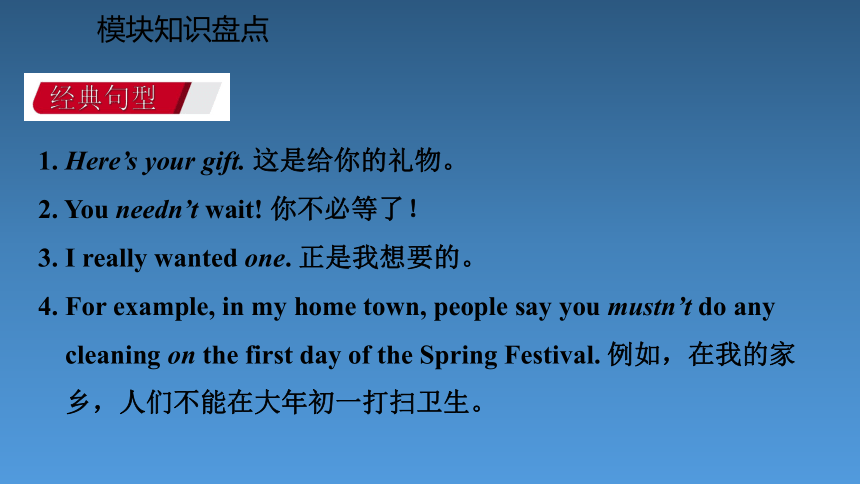


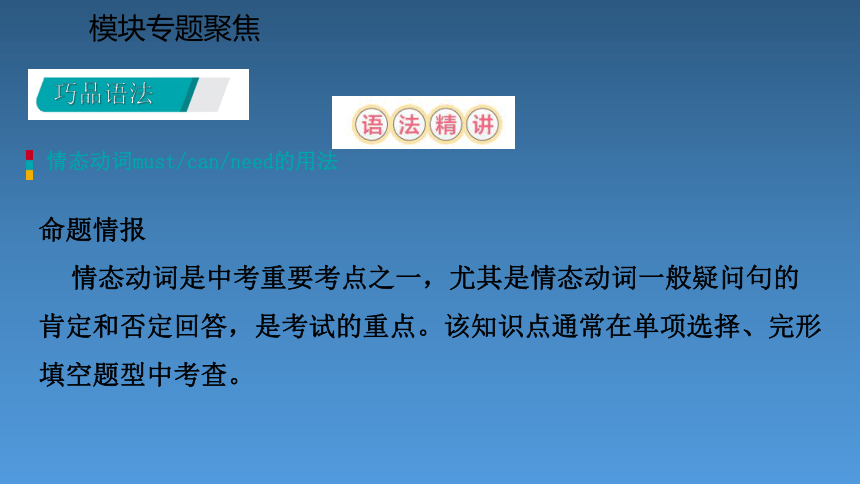

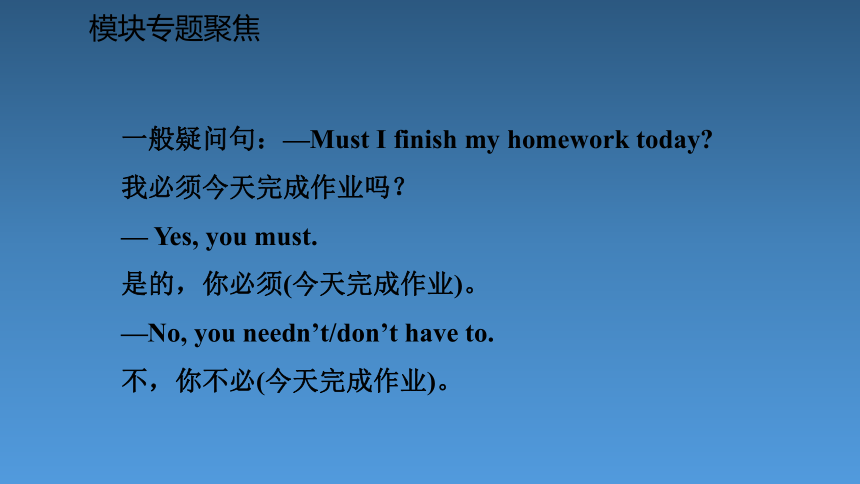

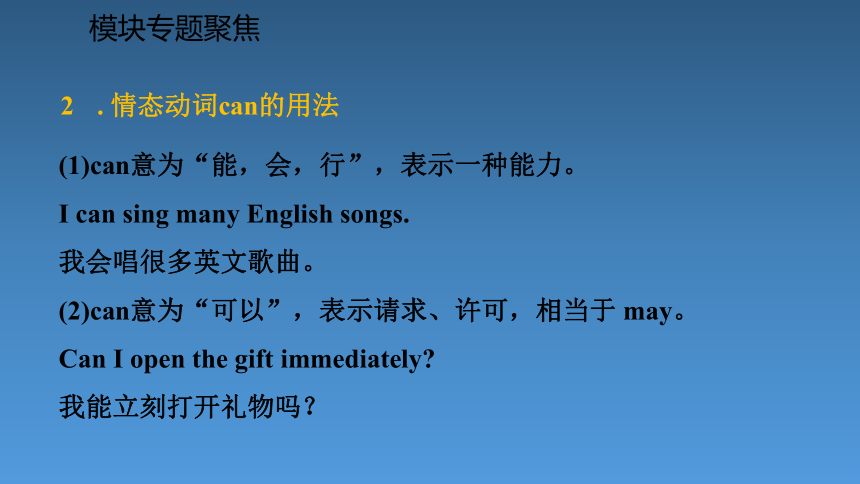
文档简介
(共38张PPT)
Module11 Way of life
模块复习课件
Module 11 Way of life
巧品语法
妙 解 写 作
阅读技巧
知识盘点
常用短语
模块知识盘点
a chess set 一副国际象棋
video game 电子游戏
3. for example 例如
4. do some cleaning 打扫卫生
5. for the first time 首次;初次
模块知识盘点
6. fish and chips 炸鱼加炸薯条
7. push one’s way 挤着前进;挤过去
8. clean up 打扫干净;整理
9. wash up 洗(餐具)
10. look up 查阅;查询
经典句型
模块知识盘点
1. Here’s your gift. 这是给你的礼物。
2. You needn’t wait! 你不必等了!
3. I really wanted one. 正是我想要的。
4. For example, in my home town, people say you mustn’t do any
cleaning on the first day of the Spring Festival. 例如,在我的家
乡,人们不能在大年初一打扫卫生。
5. You must only use red paper for hongbao...
你必须只能用红纸包红包……
6. Afternoon tea is not just a drink but a light meal at around 4 pm.
下午茶不仅仅是一种饮料,而且是下午4点左右的一顿便餐。
7. In England, you usually drink tea with milk.
在英格兰,人们喝茶时通常会加些牛奶进去。
模块知识盘点
模块知识盘点
8. You need to stand in a line and wait your turn.
你需要排队等着轮到你时再上车。
9. Sometimes people are slow to get on the bus.
有时人们上车的速度会很慢。
10. Use your dictionary to look up any words you do not understand.
用你的词典查你不理解的单词。
11. Jenny could not wait to open her birthday presents.
珍妮迫不及待地打开了她的生日礼物。
模块专题聚焦
巧品语法
情态动词must/can/need的用法
命题情报
情态动词是中考重要考点之一,尤其是情态动词一般疑问句的肯定和否定回答,是考试的重点。该知识点通常在单项选择、完形填空题型中考查。
. 情态动词must的用法
模块专题聚焦
must表示“必须,一定”,多强调说话人的主观看法,无人称和数的变化,其后接动词原形,可用于肯定句、否定句和疑问句。
肯定句:You must arrive home on time.
你必须按时到家。
否定句:You mustn’t smoke here.
你不能在这儿吸烟。
模块专题聚焦
一般疑问句:—Must I finish my homework today
我必须今天完成作业吗?
— Yes, you must.
是的,你必须(今天完成作业)。
—No, you needn’t/don’t have to.
不,你不必(今天完成作业)。
模块专题聚焦
[注意] (1)mustn’t 意为“禁止,不准,不允许”。
(2)needn’t/don’t have to 意为“不必”,由must 引导
的 一 般 疑 问 句 的 否 定 回 答 常 用“needn’t/don’t have to”。
[提示] must 可表推测,用于肯定句,意为“一定,必定”。
The girl in red must be your sister.
那个穿红衣服的女孩一定是你妹妹。
模块专题聚焦
. 情态动词can的用法
(1)can意为“能,会,行”,表示一种能力。
I can sing many English songs.
我会唱很多英文歌曲。
(2)can意为“可以”,表示请求、许可,相当于 may。
Can I open the gift immediately
我能立刻打开礼物吗?
模块专题聚焦
(3)can的否定形式为can’t,用于表示否定推测,意为
“不可能”。
That man can’t be Mr. Li, because he has gone to Beijing.
那个人不可能是李老师,因为他去北京了。
模块专题聚焦
3. 情态动词need的用法
need意为“需要”,没有人称和数的变化,可用于肯定句、否定句和疑问句。其否定形式为needn’t,意为“不需要,没必要”。
You needn’t do it again. 你不需要再做它了。
Need he do his homework first
他需要先做作业吗?
谈论风俗习惯
本模块的话题是谈论“风俗习惯”,介绍不同国家的风俗习惯和风土人情,这既开阔了学生的眼界,又让学生们了解了中外文化的差异。同时,也培养了学生的文化包容心,促进学生的跨文化交际意识的发展。
妙 解 写 作
模块专题聚焦
写 作 案 例
假如你是大明,你的外国朋友托尼即将来中国旅行,他希望你能写信给他,介绍一下中国的风俗习惯,以使他的旅行顺利、愉快。你可以从以下几个方面考虑:
模块专题聚焦
1.在中国,人们第一次见面的时候通常会互相问好并握手。当与老年人说话的时候要有礼貌、不能直呼其名。
2.去拜访朋友的时候,可以带一些诸如鲜花、水果、点心之类的礼物。
3.去参加婚礼时,人们通常会用红色的纸包红包,因为红色代表幸运。
要求:70词左右。
模块专题聚焦
素 材 积 累
词汇库
tradition 传统 custom 传统 chopsticks 筷子 gift 礼物 polite 礼貌的 attend 参加
模块专题聚焦
短语箱
shake hands 握手
for the first time 第一次
above all 毕竟
be sure 确信
have a chance to 有机会……
use...for... 用……作……
模块专题聚焦
句式链
① There are some differences between China and the US. 在中国
和美国之间有一些不同点。
② You’d better not have your hair cut during the Spring Festival
month. 你最好不要在正月剪头发。
③ Remember, don’t call their first names unless they ask you to.
记住,不要直呼其名除非他们允许。
模块专题聚焦
④ You mustn’t push your way onto the bus. 你不能挤着上公交车。
⑤ It’s a good idea to take some flowers, fruit and snacks when you
go to visit your friends.
当你拜访朋友时,带些鲜花、水果和小吃是一个好主意。
模块专题聚焦
五 步 妙 解
体裁 应用文 话题 介绍风俗习惯
时态 一般现在时和一般将来时 人称 第二人称
段落 布局 开头:用“Now, let me tell you something about Chinese traditions.”引起下文。 主体:根据题目所给的提示分条陈述。 结尾:表达祝愿“I hope...”,并再次点题,与开头相呼应。
审
模块专题聚焦
谴
模块专题聚焦
(1)我很高兴你将会来中国。
I’m glad.
You will come to China.
将以上两个简单句合并成一个含有 that 的复合句:
___________________________________________
I'm glad that you will come to China.
模块专题聚焦
(2)初次见面时,我们通常打招呼并握手。
We usually say hello and shake hands with people.
We meet for the first time.
把以上两个句子合并成一个含有when的时间状语从句: __________________________________________________________
We usually say hello and shake hands with people when we meet for the first time.
开篇点题
中间按提示
分条陈述
结尾表达祝愿
I’m glad to hear that you will come to China. Now, let
me tell you something about Chinese traditions.
We usually say hello and shake hands...
It’s a good idea to take some flowers, fruit and snacks...
If lucky enough, you may have a chance to attend a Chinese traditional wedding.
I hope you will have a good time in China.
模
模块专题聚焦
Dear Tony,
I’m glad to hear that you will come to China. Now, let me tell you something about Chinese traditions. We usually say hello and shake hands with people when we meet for the first time. We are usually polite when we speak to older people. And we can’t call them by their given names. It’s a good idea to take some flowers, fruit and snacks when you go to visit your friends. They will be very happy for your
润
模块专题聚焦
coming. If lucky enough, you may have a chance to attend a Chinese
traditional wedding. We usually use red paper for hongbao because red means luck. I hope you will have a good time in China.
Yours,
Daming
模块专题聚焦
1. 该文信息完整连贯,运用丰富的语言将提示中的中国风俗习惯完整详尽地描述了出来。
2. 文章娴熟地运用了一些好词佳句,例如:shake hands with,it’s a good idea to,have a good time以及连词if,because等。
点
模块专题聚焦
小 试 身 手
假如你叫李伟,你的英国笔友吉姆要来中国参观,请你在他来之前给他发一封电子邮件,向他介绍一下中国的习俗,主要包括:
1. 在中国必须靠右行走,这跟英国正好相反;
2. 当你碰到认识的人,打招呼问好即可,不必经常握手;
3. 吃饭要用筷子,主人通常会殷勤地给你盛饭,客人不必非得把盘子里的东西吃光;
4. 吃完饭后主人通常为客人沏茶,客人走时要有礼貌地道别。
模块专题聚焦
模块专题聚焦
注意:1. 短文必须包含以上内容;
2. 80词左右。短文的开头和结尾已经给出,不计入总词数。
提示:主人 host 代替 instead of 吃光 eat up
模块专题聚焦
Dear Jim,
How are you I’m glad to hear that you’ll come to visit China. Now let me tell you some customs in China.
I hope you will have a good time in China.
Yours,
Li Wei
One possible version:
Dear Mary,
I am glad that you will come to Liaocheng. Now let me tell you about the weather here.
In spring, the weather is warm, and there is little rain in my home town. In summer, it's very hot, and sometimes the highest temperature is about 38℃. In autumn, it is very nice. It's neither hot nor cold. It is the best season to come to Liaocheng. In winter, it's quite cold, and sometimes it snows. We all like the snow.
I am looking forward to seeing you in Liaocheng soon.
Yours,
Sun Li
模块专题聚焦
“完成表格”类的任务型阅读
完成表格”类的任务型阅读有的要求每空一词,有的则不限制每空要填的词数。此类题的题量以5道小题或10道居多,分值约为10分。
此类题的语篇材料大多是说明文,而且文章的结构清晰,层次分明,从表格中的内容可以理清文章的结构。表格的设计和文章的线索大多是保持一致的。
阅读 技 巧
模块专题聚焦
【典例】
People choose colours when they buy things. Because of this, factories want to know which colours people usually choose. For example, a car factory needs to know how many red cars or green ones they should make. Good businessmen know that young people’s colours are different from old people’s, and that men’s are different from women’s.
模块专题聚焦
Children are most interested in colours when they buy things. They like warm colours—red, yellow and orange. Blue is the colour loved by most people best. Red is the second and green the third. Women like brighter colours than men do. Almost everyone likes red, but women like yellow and green better than men do.
模块专题聚焦
If two things are same except in colour, they will look different. A red thing always looks nearer than a blue one. Also, bright things look larger than dark ones. That’s why large or fat people who want to look smaller or thinner wear dark clothes.
模块专题聚焦
【题目】根据短文内容,完成下列表格。
模块专题聚焦
People do care which colours to 1.________ when they are buying things.
Children They are most 2._________ in warm colours.
Most people They 3.__________ blue to red and green.
Women They like 4. _________colours than men do.
Large or fat people They usually wear 5._________ clothes because they want to look smaller or thinner.
choose
interested
prefer
brighter
dark
模块专题聚焦
【解析】本题属于“完成表格”类的任务型阅读。解题时要注意从文章中找出相同或相近的句子,然后再解答问题。如解答第2题时要根据第二段中的“Children are most interested in colours when they buy things.”来确定答案。
Module11 Way of life
模块复习课件
Module 11 Way of life
巧品语法
妙 解 写 作
阅读技巧
知识盘点
常用短语
模块知识盘点
a chess set 一副国际象棋
video game 电子游戏
3. for example 例如
4. do some cleaning 打扫卫生
5. for the first time 首次;初次
模块知识盘点
6. fish and chips 炸鱼加炸薯条
7. push one’s way 挤着前进;挤过去
8. clean up 打扫干净;整理
9. wash up 洗(餐具)
10. look up 查阅;查询
经典句型
模块知识盘点
1. Here’s your gift. 这是给你的礼物。
2. You needn’t wait! 你不必等了!
3. I really wanted one. 正是我想要的。
4. For example, in my home town, people say you mustn’t do any
cleaning on the first day of the Spring Festival. 例如,在我的家
乡,人们不能在大年初一打扫卫生。
5. You must only use red paper for hongbao...
你必须只能用红纸包红包……
6. Afternoon tea is not just a drink but a light meal at around 4 pm.
下午茶不仅仅是一种饮料,而且是下午4点左右的一顿便餐。
7. In England, you usually drink tea with milk.
在英格兰,人们喝茶时通常会加些牛奶进去。
模块知识盘点
模块知识盘点
8. You need to stand in a line and wait your turn.
你需要排队等着轮到你时再上车。
9. Sometimes people are slow to get on the bus.
有时人们上车的速度会很慢。
10. Use your dictionary to look up any words you do not understand.
用你的词典查你不理解的单词。
11. Jenny could not wait to open her birthday presents.
珍妮迫不及待地打开了她的生日礼物。
模块专题聚焦
巧品语法
情态动词must/can/need的用法
命题情报
情态动词是中考重要考点之一,尤其是情态动词一般疑问句的肯定和否定回答,是考试的重点。该知识点通常在单项选择、完形填空题型中考查。
. 情态动词must的用法
模块专题聚焦
must表示“必须,一定”,多强调说话人的主观看法,无人称和数的变化,其后接动词原形,可用于肯定句、否定句和疑问句。
肯定句:You must arrive home on time.
你必须按时到家。
否定句:You mustn’t smoke here.
你不能在这儿吸烟。
模块专题聚焦
一般疑问句:—Must I finish my homework today
我必须今天完成作业吗?
— Yes, you must.
是的,你必须(今天完成作业)。
—No, you needn’t/don’t have to.
不,你不必(今天完成作业)。
模块专题聚焦
[注意] (1)mustn’t 意为“禁止,不准,不允许”。
(2)needn’t/don’t have to 意为“不必”,由must 引导
的 一 般 疑 问 句 的 否 定 回 答 常 用“needn’t/don’t have to”。
[提示] must 可表推测,用于肯定句,意为“一定,必定”。
The girl in red must be your sister.
那个穿红衣服的女孩一定是你妹妹。
模块专题聚焦
. 情态动词can的用法
(1)can意为“能,会,行”,表示一种能力。
I can sing many English songs.
我会唱很多英文歌曲。
(2)can意为“可以”,表示请求、许可,相当于 may。
Can I open the gift immediately
我能立刻打开礼物吗?
模块专题聚焦
(3)can的否定形式为can’t,用于表示否定推测,意为
“不可能”。
That man can’t be Mr. Li, because he has gone to Beijing.
那个人不可能是李老师,因为他去北京了。
模块专题聚焦
3. 情态动词need的用法
need意为“需要”,没有人称和数的变化,可用于肯定句、否定句和疑问句。其否定形式为needn’t,意为“不需要,没必要”。
You needn’t do it again. 你不需要再做它了。
Need he do his homework first
他需要先做作业吗?
谈论风俗习惯
本模块的话题是谈论“风俗习惯”,介绍不同国家的风俗习惯和风土人情,这既开阔了学生的眼界,又让学生们了解了中外文化的差异。同时,也培养了学生的文化包容心,促进学生的跨文化交际意识的发展。
妙 解 写 作
模块专题聚焦
写 作 案 例
假如你是大明,你的外国朋友托尼即将来中国旅行,他希望你能写信给他,介绍一下中国的风俗习惯,以使他的旅行顺利、愉快。你可以从以下几个方面考虑:
模块专题聚焦
1.在中国,人们第一次见面的时候通常会互相问好并握手。当与老年人说话的时候要有礼貌、不能直呼其名。
2.去拜访朋友的时候,可以带一些诸如鲜花、水果、点心之类的礼物。
3.去参加婚礼时,人们通常会用红色的纸包红包,因为红色代表幸运。
要求:70词左右。
模块专题聚焦
素 材 积 累
词汇库
tradition 传统 custom 传统 chopsticks 筷子 gift 礼物 polite 礼貌的 attend 参加
模块专题聚焦
短语箱
shake hands 握手
for the first time 第一次
above all 毕竟
be sure 确信
have a chance to 有机会……
use...for... 用……作……
模块专题聚焦
句式链
① There are some differences between China and the US. 在中国
和美国之间有一些不同点。
② You’d better not have your hair cut during the Spring Festival
month. 你最好不要在正月剪头发。
③ Remember, don’t call their first names unless they ask you to.
记住,不要直呼其名除非他们允许。
模块专题聚焦
④ You mustn’t push your way onto the bus. 你不能挤着上公交车。
⑤ It’s a good idea to take some flowers, fruit and snacks when you
go to visit your friends.
当你拜访朋友时,带些鲜花、水果和小吃是一个好主意。
模块专题聚焦
五 步 妙 解
体裁 应用文 话题 介绍风俗习惯
时态 一般现在时和一般将来时 人称 第二人称
段落 布局 开头:用“Now, let me tell you something about Chinese traditions.”引起下文。 主体:根据题目所给的提示分条陈述。 结尾:表达祝愿“I hope...”,并再次点题,与开头相呼应。
审
模块专题聚焦
谴
模块专题聚焦
(1)我很高兴你将会来中国。
I’m glad.
You will come to China.
将以上两个简单句合并成一个含有 that 的复合句:
___________________________________________
I'm glad that you will come to China.
模块专题聚焦
(2)初次见面时,我们通常打招呼并握手。
We usually say hello and shake hands with people.
We meet for the first time.
把以上两个句子合并成一个含有when的时间状语从句: __________________________________________________________
We usually say hello and shake hands with people when we meet for the first time.
开篇点题
中间按提示
分条陈述
结尾表达祝愿
I’m glad to hear that you will come to China. Now, let
me tell you something about Chinese traditions.
We usually say hello and shake hands...
It’s a good idea to take some flowers, fruit and snacks...
If lucky enough, you may have a chance to attend a Chinese traditional wedding.
I hope you will have a good time in China.
模
模块专题聚焦
Dear Tony,
I’m glad to hear that you will come to China. Now, let me tell you something about Chinese traditions. We usually say hello and shake hands with people when we meet for the first time. We are usually polite when we speak to older people. And we can’t call them by their given names. It’s a good idea to take some flowers, fruit and snacks when you go to visit your friends. They will be very happy for your
润
模块专题聚焦
coming. If lucky enough, you may have a chance to attend a Chinese
traditional wedding. We usually use red paper for hongbao because red means luck. I hope you will have a good time in China.
Yours,
Daming
模块专题聚焦
1. 该文信息完整连贯,运用丰富的语言将提示中的中国风俗习惯完整详尽地描述了出来。
2. 文章娴熟地运用了一些好词佳句,例如:shake hands with,it’s a good idea to,have a good time以及连词if,because等。
点
模块专题聚焦
小 试 身 手
假如你叫李伟,你的英国笔友吉姆要来中国参观,请你在他来之前给他发一封电子邮件,向他介绍一下中国的习俗,主要包括:
1. 在中国必须靠右行走,这跟英国正好相反;
2. 当你碰到认识的人,打招呼问好即可,不必经常握手;
3. 吃饭要用筷子,主人通常会殷勤地给你盛饭,客人不必非得把盘子里的东西吃光;
4. 吃完饭后主人通常为客人沏茶,客人走时要有礼貌地道别。
模块专题聚焦
模块专题聚焦
注意:1. 短文必须包含以上内容;
2. 80词左右。短文的开头和结尾已经给出,不计入总词数。
提示:主人 host 代替 instead of 吃光 eat up
模块专题聚焦
Dear Jim,
How are you I’m glad to hear that you’ll come to visit China. Now let me tell you some customs in China.
I hope you will have a good time in China.
Yours,
Li Wei
One possible version:
Dear Mary,
I am glad that you will come to Liaocheng. Now let me tell you about the weather here.
In spring, the weather is warm, and there is little rain in my home town. In summer, it's very hot, and sometimes the highest temperature is about 38℃. In autumn, it is very nice. It's neither hot nor cold. It is the best season to come to Liaocheng. In winter, it's quite cold, and sometimes it snows. We all like the snow.
I am looking forward to seeing you in Liaocheng soon.
Yours,
Sun Li
模块专题聚焦
“完成表格”类的任务型阅读
完成表格”类的任务型阅读有的要求每空一词,有的则不限制每空要填的词数。此类题的题量以5道小题或10道居多,分值约为10分。
此类题的语篇材料大多是说明文,而且文章的结构清晰,层次分明,从表格中的内容可以理清文章的结构。表格的设计和文章的线索大多是保持一致的。
阅读 技 巧
模块专题聚焦
【典例】
People choose colours when they buy things. Because of this, factories want to know which colours people usually choose. For example, a car factory needs to know how many red cars or green ones they should make. Good businessmen know that young people’s colours are different from old people’s, and that men’s are different from women’s.
模块专题聚焦
Children are most interested in colours when they buy things. They like warm colours—red, yellow and orange. Blue is the colour loved by most people best. Red is the second and green the third. Women like brighter colours than men do. Almost everyone likes red, but women like yellow and green better than men do.
模块专题聚焦
If two things are same except in colour, they will look different. A red thing always looks nearer than a blue one. Also, bright things look larger than dark ones. That’s why large or fat people who want to look smaller or thinner wear dark clothes.
模块专题聚焦
【题目】根据短文内容,完成下列表格。
模块专题聚焦
People do care which colours to 1.________ when they are buying things.
Children They are most 2._________ in warm colours.
Most people They 3.__________ blue to red and green.
Women They like 4. _________colours than men do.
Large or fat people They usually wear 5._________ clothes because they want to look smaller or thinner.
choose
interested
prefer
brighter
dark
模块专题聚焦
【解析】本题属于“完成表格”类的任务型阅读。解题时要注意从文章中找出相同或相近的句子,然后再解答问题。如解答第2题时要根据第二段中的“Children are most interested in colours when they buy things.”来确定答案。
同课章节目录
- Module 1 How to learn English
- Unit 1 Let's try to speak English as much as possi
- Unit 2 You should smile at her.
- Unit 3 Language in use .
- Module 2 My home town and my country
- Unit 1 It's taller than many other buildings.
- Unit 2 Cambridge is a beautiful city in the east o
- Unit 3 Language in use .
- Module 3 Sports.
- Unit 1 Nothing is more exciting than playing tenni
- Unit 2 This year we training more carefully.
- Unit 3 Language in use .
- Module 4 Planes, ships and trains .
- Unit 1 He lives the farthest from school.
- Unit 2 What is the best way to travel.
- Unit 3 Language in use .
- Module 5 Lao She Teahouse.
- Unit 1 I wanted to see the Beijing Opera.
- Unit 2 It descibes the changes in Chinese society.
- Unit 3 Language in use .
- Module 6 Animals in danger.
- Unit 1 It allows people to get closer to them .
- Unit 2 The WWF is working hard to save them all.
- Unit 3 Language in use .
- Revision module A
- Module 7 A famous story
- Unit 1 Alice was sitting with her sister by the ri
- Unit 2 She was thinking about her cat.
- Unit 3 Language in use .
- Module 8 Accidents
- Unit 1 While the car were changing to red, a car s
- Unit 2 I was trying to pick it up when it bite me
- Unit 3 Language in use .
- Module 9 Population
- Unit 1 The population of China is about 1.37 billi
- Unit 2 Arnwick was a city with 200,000 people.
- Unit 3 Language in use .
- Module 10 The weathe
- Unit 1 It might snow.
- Unit 2 The weather is fine all year round.
- Unit 3 Language in use .
- Module 11 Way of life
- Unit 1 In China ,we open a gift later.
- Unit 2 In England, you usually drink tea with milk
- Unit 3 Language in use .
- Module 12 Help
- Unit 1 What should we do before help arrives?
- Unit 2 Stay away from windows and heavy furniture.
- Unit 3 Language in use .
- Revision module B
